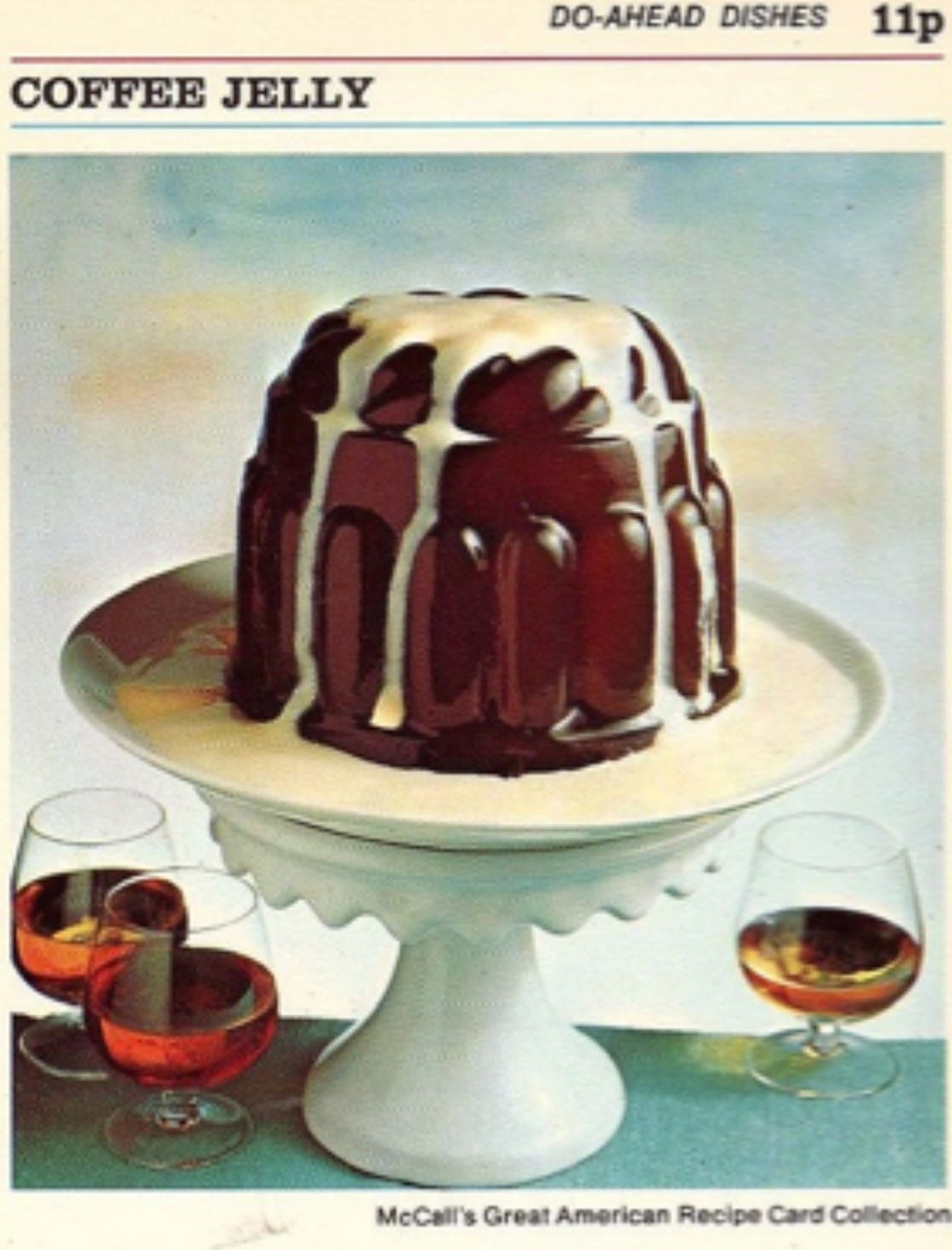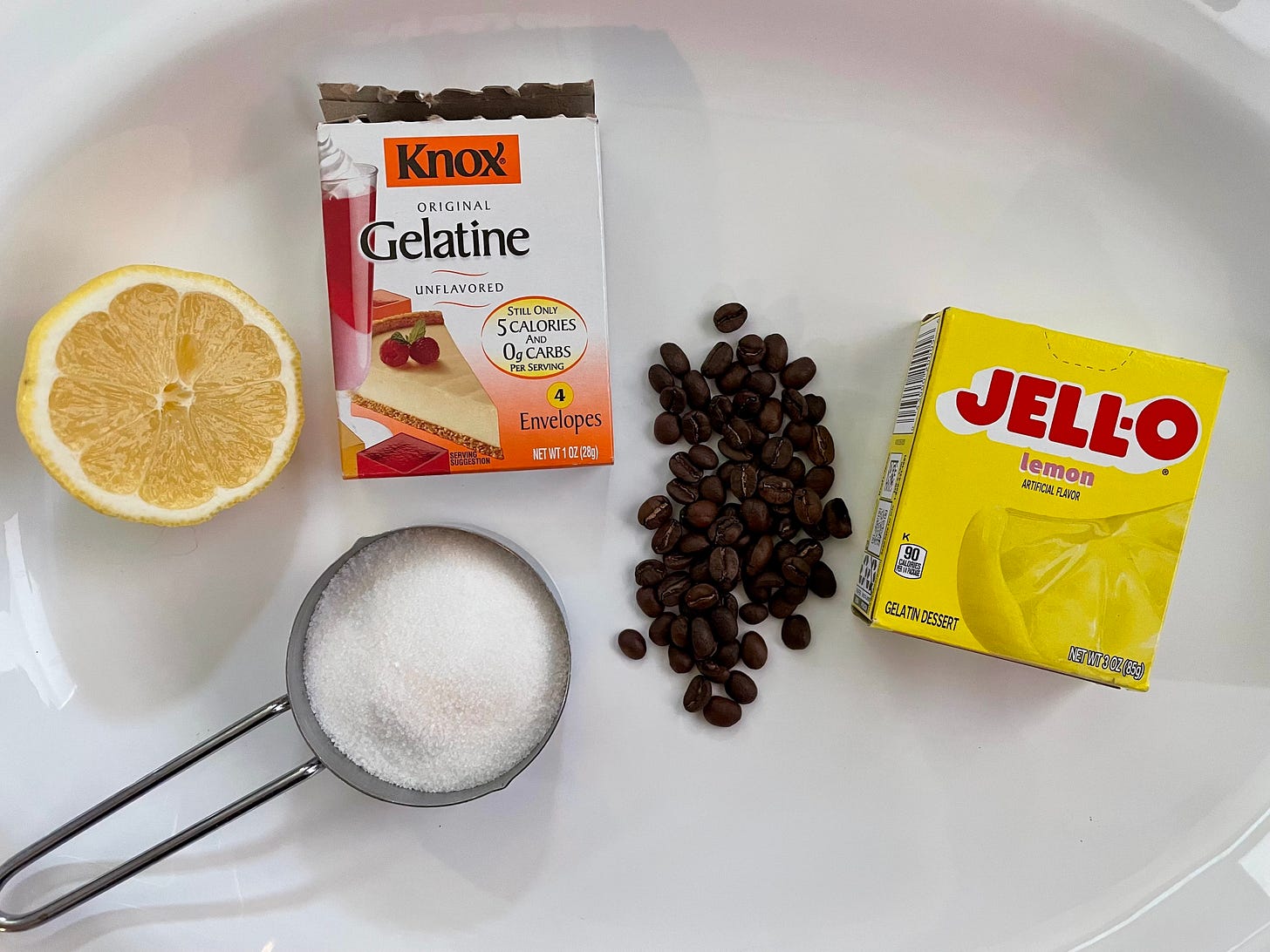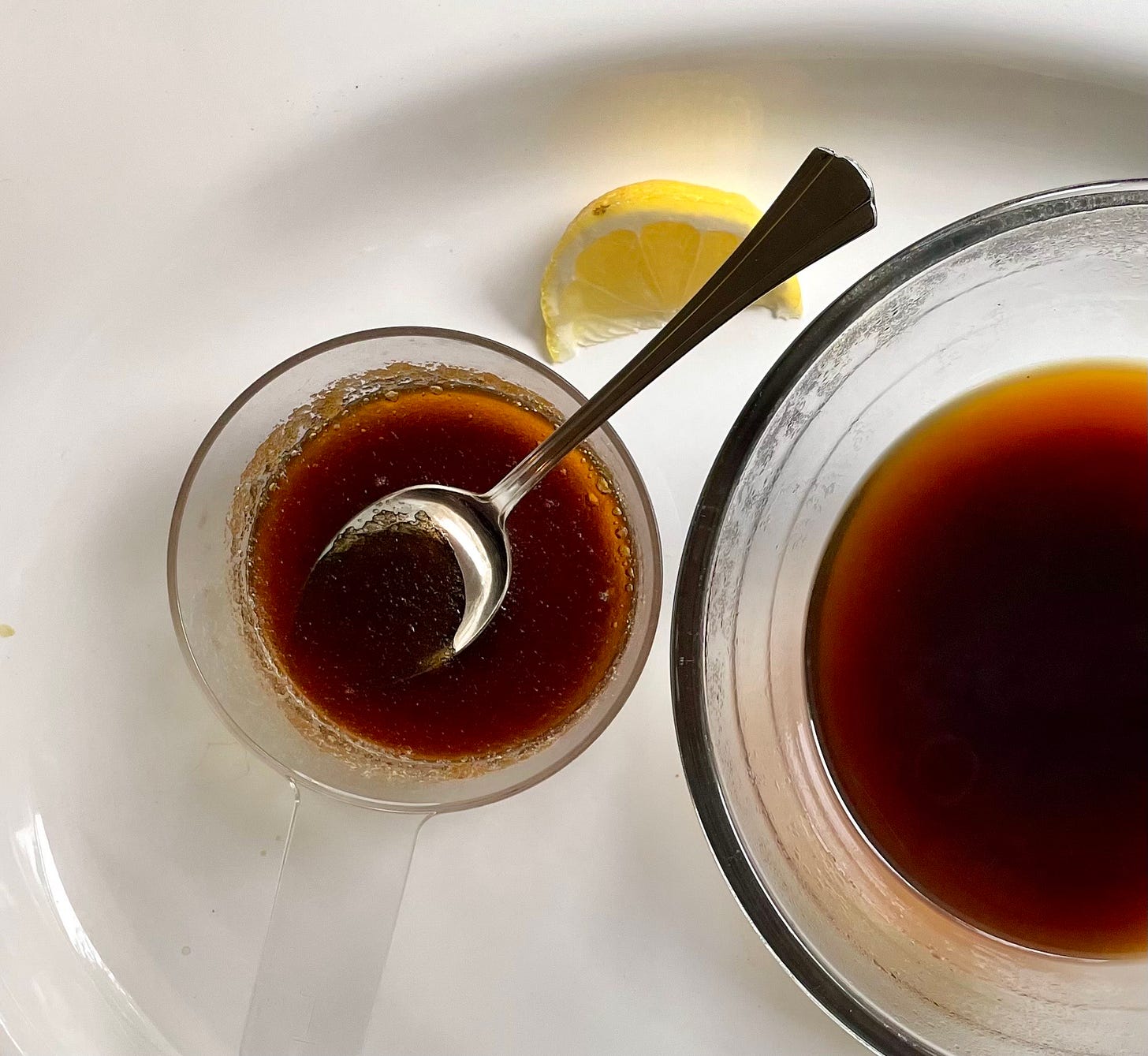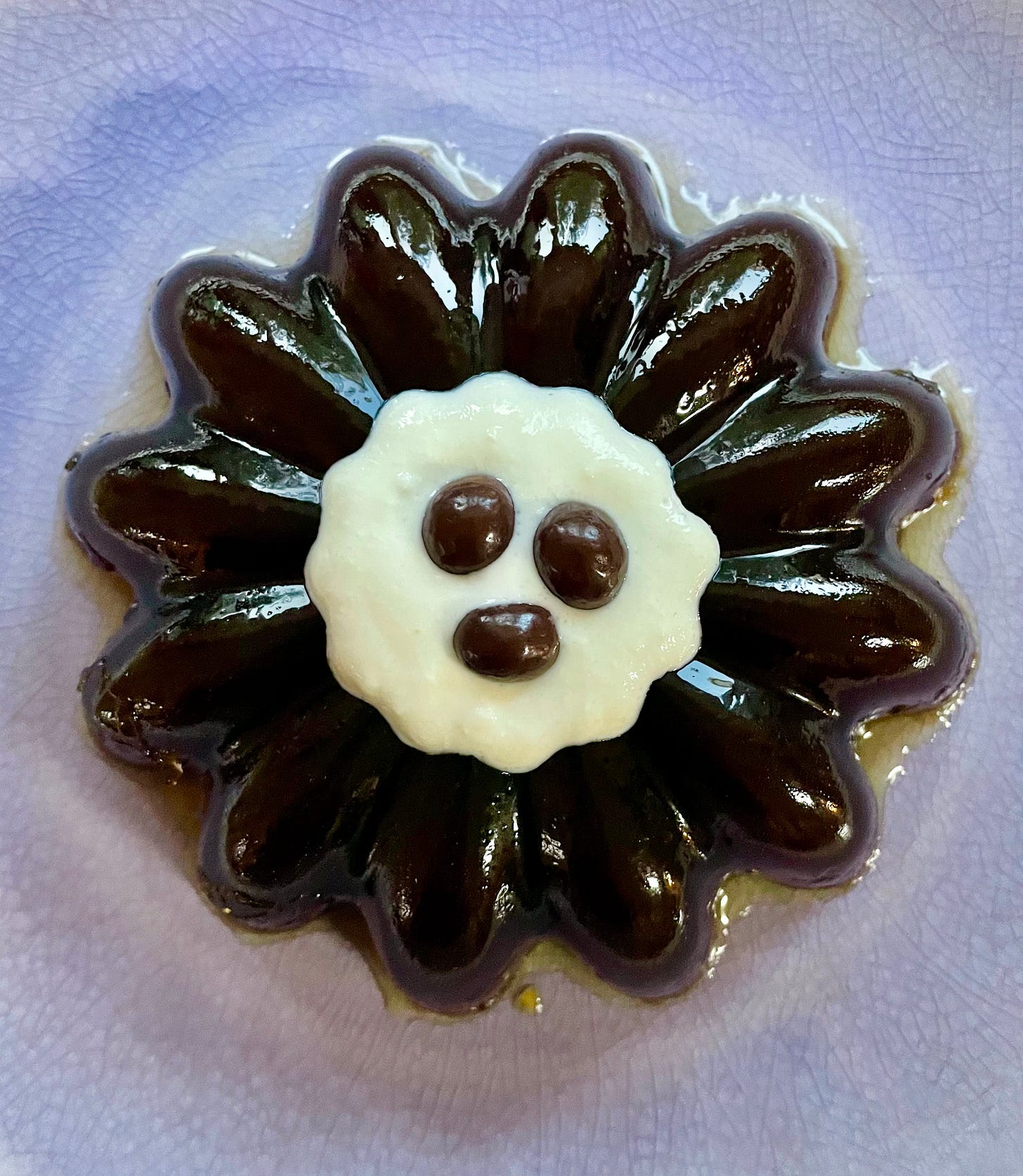Vintage Recipe Roulette: 1925 & 1973 Coffee Jell-Os
The best part of waking up is Jell-O in your cup
Nothing better than a cup o’ Joe, right? It’s one of my favorite joys in life, but I usually have it hot and steamy. Today, we’re doing cold and squishy.
Coffee gelatin was reportedly invented in Japan in the early 1900s, but it made its way here soon after. It’s still common in Japan (here’s a modern recipe using kanten seaweed jelly and instant coffee), and there even used to be a coffee flavor package of Jell-O. Although it’s not in my 1927 Jell-O pamphlet, my 1933 Jell-O pamphlet, or my 1968 Joys of Jell-O cookbook, there are other Jell-O cookbooks instructing blending coffee with lemon Jell-O, starting in 1925 or so. It’s interesting to me that it’s so comparatively rare; perhaps it didn’t ever really catch on in the states. I don’t think the boxed coffee version lasted long since I’ve only ever seen one early 1900s package design.
But, before the branded one was marketed, the American recipes for coffee jelly used unflavored gelatin and a bit of lemon juice. I suspect the lemon brightens and intensifies the flavor — often when things are cold, they can taste flat, and adding a pinch of salt and a hint of acid can liven it up. If you look at it that way, maybe it’s not so horrifying?
I’ve actually wanted to make this recipe for a long time, and it came to mind last week when I reviewed a viral wine hack for TODAY.com — adding jalapeno to Sauvignon Blanc. That idea had such a nice effect — because there are compounds in sauv b that are similar to green pepper, the two ingredients actually enhanced each other. Tasting the jalapeno opened up the flavors inherent in the wine, and helped me understand it. I had a flashback to the first time I tried an iced African coffee with a lemon bar. African coffees are often more acidic and fruity than those grown other places — it’s a combination of the growing conditions, the soil, and processing method — some wash the cherry off the bean immediately, leaving a crisp flavor, and others dry the beans with the coffee cherry still around it, imparting a fruity note. They’re the only kind of coffee I really enjoy without any creamer or sugar, but I didn’t appreciate them so much until I tried a blend with that lemony pairing. It was like I suddenly understood the flavor by tasting them together.
So, as weird as this lemon coffee Jell-O sounds, I’m kind of excited to try it! I just have to pick a version…
Click here for one from 1937 that does not use lemon; it’s just coffee, sugar, and gelatin. I love the wartime thrift aspect — it specifies using leftover coffee. The comments on that viral jalapeno wine post boil down to everyone making the same joke about the improbability of leftover wine, and I feel the same way about coffee, but back then people were often brewing a whole big percolator pot that would only work if it was at least halfway full. (Here’s a 1951 manual in case you’ve never heard of this contraption! I remember my grandmother’s, and her pink melamine coffee cups.)
There are a number of versions of coffee molds made with unflavored gelatin with lemon juice added. This one has 3 1/2 c liquid to 2 packages of gelatin, while this one from McCall’s 1973 recipe card collection has a whole packet of gelatin per cup of coffee. This is equivalent to Jell-O Jiggler territory, perhaps firmer than I would like, plus it has an egg-based custard sauce, ugh.
The earliest American version with lemon flavored Jell-O that I can find online is from a 1925 advertising pamphlet, and it’s simpler: 2 c hot coffee, 1 3 oz package of lemon Jell-O, and 2 T extra sugar.
I really want to try both for comparison, so I’m going to layer the 1925 lemon Jell-O one with the 1973 McCall’s unflavored gelatin one. Here are the ingredients for both. I’m using freshly ground and brewed whole beans, which is hilariously at odds with the package of shock yellow fake lemon gelatin.
First I’ll pour the hot coffee on the lemon Jell-O powder (I’m using 1 3/4 c coffee so it’s a bit more sturdy and moldable than originally written, but if you’re planning for cubes, that’s not necessary) and add the extra sugar, and then pour into my mold. It’ll chill until barely firm — don’t wait too long when layering, or your layers will not adhere.
Once that’s done, I’ll bloom 1 packet of Knox unflavored with 1/4 c cold coffee (this is a very important step that prevents clumping with unflavored gelatin), and add 1 c hot coffee, 1/4 c of sugar, and 1 tsp lemon juice for the second layer. Once we unmold, it’ll be on the bottom, and though that extra 1/4 I used for blooming will make it softer than the original recipe because I’m hoping to avoid tooth-squeaking, it’ll still be firm enough to hold up my chosen bombe mold shape.
I can’t bring myself to make the custard sauce, but since that recipe specifies that you could also use cream, I feel justified in thinning out some vanilla yogurt with a little milk.
Here it is all turned out! I garnished with chocolate covered espresso beans and enjoy that it looks like it’s screaming.
It’s hard to make out in the photos, but I can see the difference between the top and bottom layer. The 1973 one is just a tad darker. As for flavor, I am very surprised to report that I prefer the Lemon Jell-O part. It’s bright without tasting lemony, and the coffee flavor is enhanced. Although it’s not chewy like real grass jelly boba, it wouldn’t be crazy to serve it that way, in milk or an iced latte. It would be amazing for a 1920s or 1930s-themed party.
The 1973 version with just a squeeze of lemon and unflavored gelatin is still good, though, and I think that recipe would be best if you wanted to add milk or plant-based milk into the gelatin itself. You could replace the coffee with milk and then add 1 oz of espresso per envelope of gelatin, and a layer with a splash of your favorite flavored creamer in it might be fun. Or, you could use milk with a passable instant coffee, like Kuju or Starbucks instant. I wouldn’t suggest a cheaper instant brand unless you have one you already like for iced coffee. For the record, I used Ruta Maya beans, which taste amazing and are grown with both people and environment in mind (not an ad, I just love them). It’s kind of a shame that I adulterated such a special coffee with Jell-O, but on the other hand, it elevated Jell-O to a higher purpose.
This brings up an important point that you’ll already be aware of if you often order iced espresso drinks — chilling brings out some of the less desirable flavors like bitterness or burned notes. For any cold drink or dessert with coffee, it’s important to use one that tastes really good and is brewed properly.
Otherwise, your face might look like this:
Need food-first, picky eater-friendly, non-judgmental help with nutrition? You can schedule an appointment with me through Nourish here. I promise I will not suggest you eat ketchup cookies or Jell-O salad. I see lots of diabetes, neurodivergence, allergies and GI conditions, autoimmune and inflammatory disorders, and weight management whether for increase or decrease — adults, teens, and kids. We take most insurance, and most often, the copay is $0.
Zen and the Science of Candy Corn is a reader-supported publication that brings me great joy. You can literally give me your 2 cents with the tip jar button below!
Thanks so much for reading! But if you decided to subscribe, free or paid? Just my cup of Jell-O tea.
And feel free to share this post with any instant Nescafe-loving psychopaths you know.









